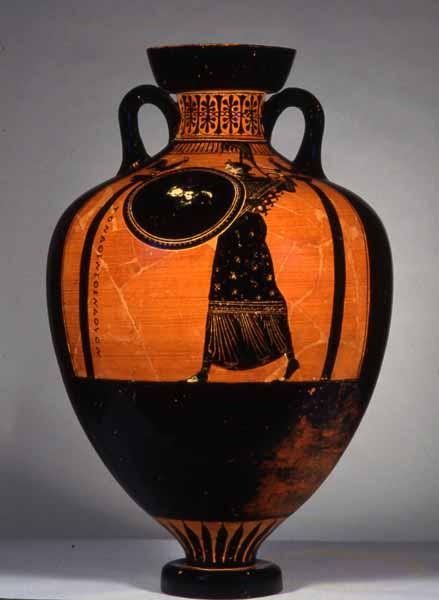Panathenaic Prize Amphora (Award trophy)
Artist: Manner of the Kleophrades Painter (Greek)
Date: about 490 BCE
Dimensions:
H: 25 in. (63.5 cm); Diam (mouth): 7 in. (7.8 cm); Diam (body): 16 5/32 in. (41 cm); Diam (foot): 5 11/16 in. (14.4 cm)
Medium: Black Figure; Wheel-thrown, slip-decorated earthenware with incised details
Place of Origin: Greece, from Attica
Classification: Ceramics
Credit Line: Purchased with funds from the Libbey Endowment, Gift of Edward Drummond Libbey
Object number: 1961.24
Label Text:The Panathenaic games were held in Athens every four years in honor of the goddess Athena. In contrast to other games in which the prizes were purely symbolic wreaths, the Panathenaic games awarded victors large decorated storage jars (amphorae) filled with olive oil from the sacred groves of Athena. Although today we prize the amphorae as works of art, it was actually the olive oil that was the prize.
The scene on the front shows the goddess Athena and is a traditional composition found on all Panathenaic amphorae. On the back is shown the competition for which the prize was awarded: the Pankration. The two athletes are shown with a judge between them. This was a particularly vicious combat sport involving boxing, wrestling, kicking, and twisting. There were some rules, however. Biting and gouging were forbidden—except at Sparta.
The scene on the front shows the goddess Athena and is a traditional composition found on all Panathenaic amphorae. On the back is shown the competition for which the prize was awarded: the Pankration. The two athletes are shown with a judge between them. This was a particularly vicious combat sport involving boxing, wrestling, kicking, and twisting. There were some rules, however. Biting and gouging were forbidden—except at Sparta.
DescriptionFront: Athena between two doric columns surmounted by roosters; Back: Pankration (combination of wrestling and boxing)
On view
In Collection(s)

























